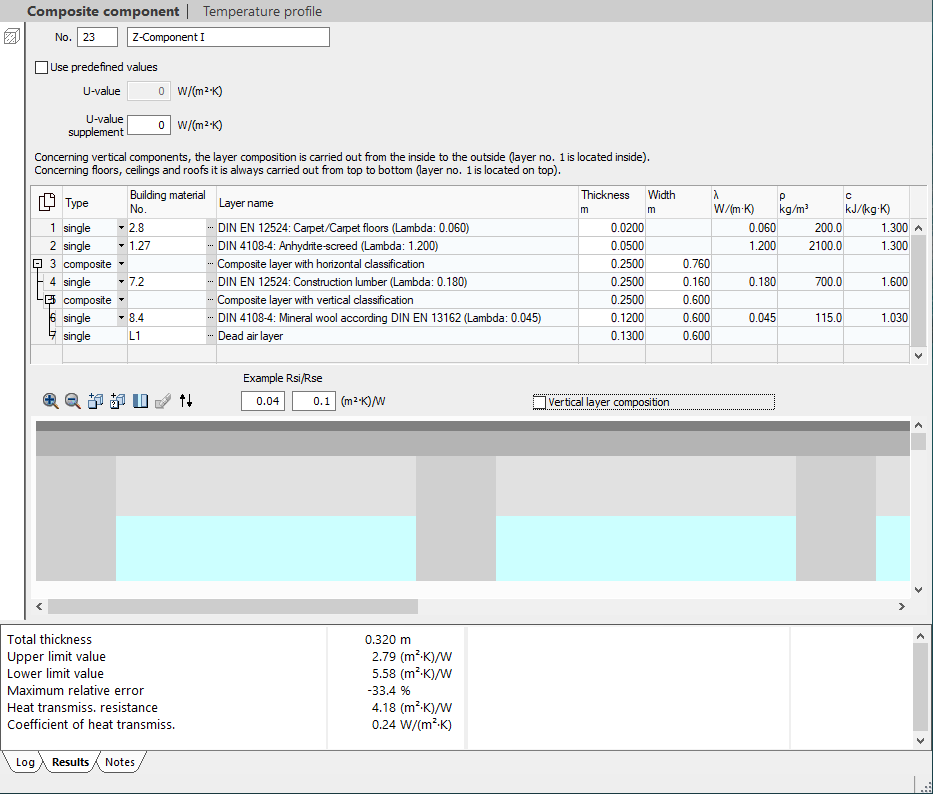Details on Composed Component
Information about the Composed component section in the Master Tables workspace.
Components such as walls consist of different layers. You can define such components as layered components with the specification of the individual layers and the material properties of the layers.
You are here:

No. Consecutive number in the name of the component. A component number may only appear once in the Components folder.
Name: Name of the component, displayed in selection table.
Use predefined values
Activated: The U-value text box is activated and you can enter a U-value for the component.
Deactivated: To define a layered component, the table and the graphic layer editor are displayed.
U-value supplement
If the U-value of a component is to be adjusted, e.g. due to facade fasteners, you can enter the corresponding correction supplement here.
Table
You can define the layered composition of the component in the table. The first layer is always inside or on top.
| Column | Description |
|---|---|
| Type | Choice between single (continuous layer) and composed (repeating element, such as beams in a wood joist ceiling). |
| Building material No. | If known, the material number can be entered directly. You can also enter the desired building material as a search term in the field and press Enter to display the hit list in the Building Material List dialog. Clicking also opens the Building material list dialog, where you can either search for the desired building material or select it directly. |
| Layer name | Name of the layer or building material. |
| Thickness, Width, Height | Thickness and width respectively height of the layer. For layer of type single the width or height field is not editable. Once a layer is composed, the distance at which a building material repeats is determined by the width of the building materials in between. |
| Thermal conductivity Lambda | The heat conductivity of a building material describes how well it conducts heat. It is required for the calculation of the U-value. |
| Consistency | The density of a building material is used to calculate the thermal storage capacity in the dynamic cooling load calculation. |
| Specific heat capacity | The specific heat capacity describes the ability of a substance to store thermal energy. This value is used to calculate the thermal storage capacity in the dynamic cooling load calculation. |
Graphical layer editor
 : Enlarges or reduces the display of the current layer structure.
: Enlarges or reduces the display of the current layer structure.
 : Opens the Material List dialog for selecting a building material and allows you to insert the selected building material at the selected position.
: Opens the Material List dialog for selecting a building material and allows you to insert the selected building material at the selected position.
 : Allows you to insert a free layer with self-defined building material at a selected position.
: Allows you to insert a free layer with self-defined building material at a selected position.
 : Opens the Select type of air layer dialog where you can insert a dead or weakly or strongly circulating air layer.
: Opens the Select type of air layer dialog where you can insert a dead or weakly or strongly circulating air layer.
 : Removes the currently selected layer.
: Removes the currently selected layer.
 : Reverses the layer order.
: Reverses the layer order.
Example Rsi/Rse: Example values for heat transmission resistances with which you would like to test the U-value for a specific installation situation. The finally used heat transmission resistances depend on the calculation module and on the installation situation of the component. They are only determined when they are actually used..
Vertical layer composition
Activated: Inserts the selected building materials vertically from left to right.
Deactivated: Inserts the selected building materials horizontally from top to bottom.